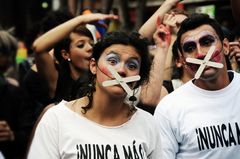The majority of the marchers who took to the rainy streets of Bogota at the end of April with flags and picket signs calling for peace and social justice —some 50 and 80 thousand of them—had travelled up to 20 hours by bus from the rural corners of Colombia. Some 1700 organisations began planning the Patriotic March two years ago, resulting in one of the largest mobilisations in Colombian history—an initiative that seeks to become a real democratic alternative for the country.1
On these same streets, just weeks before, hundreds of people marched to commemorate the National Day of Memory and Solidarity with Victims of the Armed Conflict. These mobilisations, expressions of different social struggles, have been on the rise in the last decade. According to the Centre for Research and Popular Education (CINEP), an organisation that gathers data on social struggles, of the 7,000 mobilisations that took place between 1975 and 2012, more than half emerged over the last ten years.2
“Today there is a multiplicity of different social expressions and a great capacity to organize and come together,” according to Luis Eduardo Celis, analyst for the Research Centre Corporation Nuevo Arcoiris (New Rainbow).3
Diverse social movements have incorporated new strategies that have had a positive effect in their efforts to reclaim their rights. “These are movements that have matured and no longer favour direct action alone to mobilise and denounce, but combine these actions with legal strategies, international political advocacy, and the dissemination of information through the media so that their interests are also heard,” states Celis. He also adds that the most successful movements are those that combine a number of these activities. In this vein, Mauricio Archila, historian and analyst of social movements for CINEP, says the social movements that achieve the most are those that are able to avoid violent confrontations.4
There are many concrete examples of the success had by social movements. Last year, a planned mining project that would have threatened the Santurban highlands (Santander) brought social organisations and environmentalists together to lead a movement that rejected the plan´s implementation. The legal actions taken as well as the mobilisation of thousands of people succeeded in halting Canadian company Greystar from moving forward with its gold extraction project.5
The Victim´s Movement, an ethical cornerstone
For Celis, one of the most important social movements of the last decade has been the victim’s movement. A decade ago, a good number of Colombian citizens were unaware of the magnitude of suffering experienced by victims of the armed conflict. “Urban sectors of Colombian society have begun to be aware that there are victims and to recognize the importance that they vindicate their rights.” This new protagonism is also reflected in CINEP´s statistics. Victim´s associations have led 945 social struggles between 1975 and 2010, with 764 of those actions (80%) carried out over the last decade.6
The National Movement for Victims of State Crimes (MOVICE) emerged as a part of an investigative project called Colombia Never Again that documented crimes against humanity.7 The 1500 victims that were present at a 2005 gathering resolved to create MOVICE and develop strategies in the fight against impunity. Within the movement, 283 organisations work together. Today, they have gained recognition and hold an important position within Colombian society. Movice is an “ethical cornerstone,” affirms Eliana Leaño Valverde, one of its members.8 She recalls that among the most important successes of the last 7 years was the vast mobilization on March 6, 2008 where millions of people marched in Colombia and internationally in the name of victims of paramilitaries and state actors.9 They also organized citizen hearings where victims could denounce human rights violations. These citizen hearings were markedly different than the hearings held in the context of the Justice and Peace Law (Law 975 of 2005) where victims could only intervene indirectly through the prosecutor. This was done in such a way that everything revolved around the perpetrator’s declarations while the victims were relegated to a role of spectators, forced to watch on in silence. The citizen hearings actually provided victims of the armed conflict a platform to denounce human rights violations, explains Leaño Valverde.10 MOVICE has since expanded and currently has 22 regional chapters throughout the country.
Returning a Voice to the People
According to human rights defender and forensic anthropologist Berenice Celeyta another significant movement is the Peoples’ Congress that emerged as the “Minga”11 of social and communitarian resistance. The objectives highlighted by Celeyta included “thinking together about our proposal for an inclusive country utilizing the legislation of its different peoples and giving voice to those whose voice has been taken.”12
There were two Peoples’ Congresses held between 2010 and 2011 with approximately 90,000 participants.13 In the most recent Congress, representatives from indigenous, peasant farmer and afro-descendant communities arrived in the city of Cali to discuss the armed conflict, the dispossession they have suffered, and the defence of the ancestral lands of ethnic minorities.
Celeyta holds the following to be some of the concrete achievements of the Peoples’ Congress: making visible what really occurs in Colombia; formulating concrete demands towards the Government that resulted in halting legislative projects that “were to the detriment of the rights of different peoples and environmental rights;” and bringing together diverse communities. Celeyta also emphasizes the necessity to join forces among the different social sectors. “We can´t do it alone” she says, underlining that in the past different mobilisations and resistance occurred in each of the sectors—women, peasant farmers, indigenous peoples—but they each had developed their own specific strategies to vindicate their rights.
The Challenges
Celeyta emphasizes: “We’re not all here yet. There are still many people afraid to come out on the streets and there are still many people afraid to express what they think.” One of the most important challenges are the pressures—threats, killings, and stigmatisation –that are faced by leaders and participants of human rights organisations. “It´s truly heroic that there are still organisations in the countryside” says Celis, expressing his admiration for the courage of the people. In the year 2011, according to different registries by non-governmental organisations, at least 28 people were killed who were linked processes of land restitution as peasant farmers and as victims of displacement and dispossession.14
In terms of the comparison with other countries in Latin America (especially Bolivia, Brazil, Argentina, and Mexico), Colombia has not had the same tradition of organizing or strong social mobilisation, explains Archila, and this has to do with the history of violence. Despite this “relative weakness”, she observes that taking into account the conditions in Colombia—armed conflict, the presence of armed actors, and violence—“there are some very interesting dynamics.”
According to Celeyta, it is still important that social movements are strengthened and become more unified. “Trust is not built from one day to the next. Trust begins with respect for differences and in thinking that each of the opinions that exists is valid for the transition process.”

